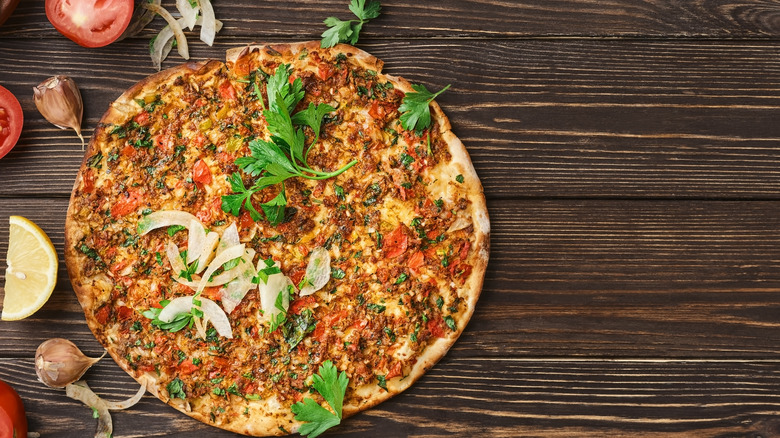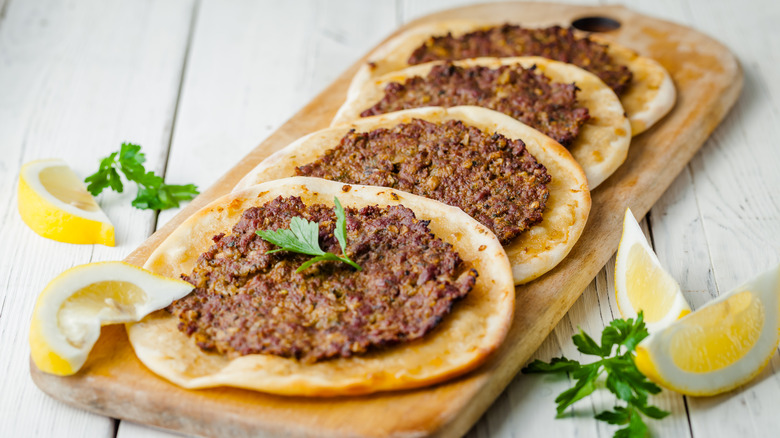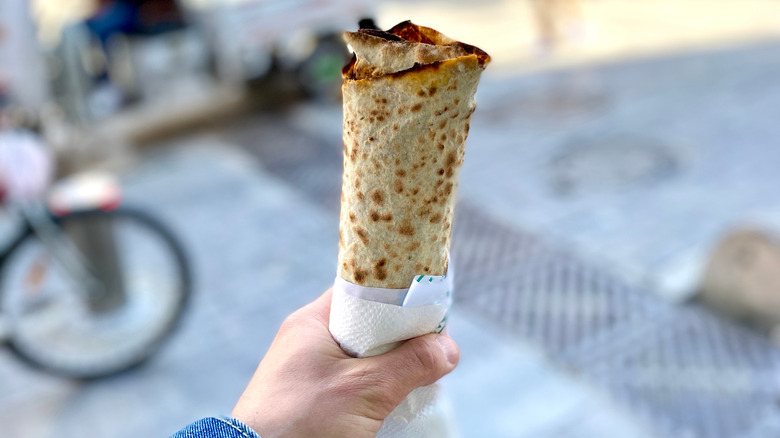Lahmajun: A $2 Snack 'Pizza' That Deserves Way More Hype
If someone described eating a round, thin-crusted bread topped with flavourful meat and tomatoes, most people would assume they were describing pizza, though they could just as easily be talking about lahmajun (also spelled lahmacun or lahmajo). From Italy to Indonesia, there are franchises dedicated to the famous foodstuff and it sets the standard for being an international-yet-localized dish, with tons of regional variations. The fact that pizza is the food of choice for the Teenage Mutant Ninja Turtles has also helped to sear the dish into our collective pop culture memories.
In comparison, there are no advertisement jingles for lahmajun, which is often described as "Turkish pizza" or "Armenian pizza" although it is also popular across the Levant. This comparison to pizza is inevitable because broadly, lahmajun is a thin, crispy flatbread topped with minced meat, onions, and chili peppers and baked in a wood-fired oven. However, this is where their similarity ends. While pizza traditionally has gooey, melted cheese on top, there is often no cheese on lahmajun. Instead, it has warmer flavors and is garnished with lemon and parsley for a tangy aftertaste.
Tomato sauce or tomato paste, however, is a divisive ingredient. Some claim it does not belong in lahmajun while others recommend using tomato paste to cook the meat topping.
What is the appeal of lahmajun?
To the untrained eye, lahmajun is a simple dish featuring bread and meat. What then, is its appeal? As Hussein Aktas, owner of Mangal Pide & Lahmacun Solonu restaurant in the U.K. told Vice, the secret is in getting the balance between the different ingredients (tomato, minced lamb, onion, parsley, sumac, and chili) just right.
Stateside, the best place to find lahmajun is in Armenian or Turkish bakeries and it is usually sold alongside other Turkish food like boreks. It typically costs approximately $2 for a snack-sized lahmajun, which is a bargain given the ingredients and flavor. It also means that it is perfect as a single-serve food on the go, which explains why it is a popular street food in Türkiye.
If you are worried about spilling the meat and causing a mess, just fold the lahmajun in half and eat it like a tortilla. Since the flatbread is thin and crispy, you should hear a satisfying crunch.
Lahmajun is a heavily contested dish
While Australians and New Zealanders have a friendly debate about who first invented the pavlova, the debate about lahmajun is more heated. Both Armenia and Türkiye claim lahmajun is part of their national heritage. This escalated in 2016 when Armenians opened restaurants in Russia and started an international drive to promote lahmajun as an Armenian dish, sparking indignation among Turks.
Ironically, lahmajun is also contested among several regions in southern Türkiye. Gaziantep, Adana, and Şanliurfa have a long-standing rivalry over ownership of the dish. Gaziantep and Şanlıurfa went so far as to apply for a patent (which they received) for lahmajun with the Turkish Patent and Trademark Office.
Part of this skirmish is because food tends to be a regional fare, just like the difference between Roman and Neapolitan pizza. Any attempt to make it national or nationalistic is bound to be complicated. For people who are new to lahmajun, knowing this history and context may deepen their appreciation for this underrated dish.


